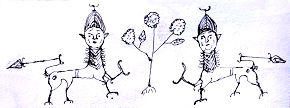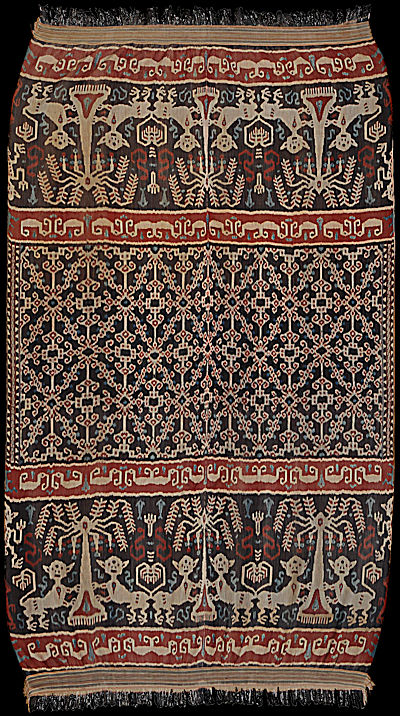| |
351 Sumba, East Sumba
Hinggi (men's blanket)
|
| Locale: | Unidentified. |
| Period: | Late 19th or early 20th c. |
| Yarn: | Cotton, hand-spun, extremely fine, double-ply |
| Technique: | Warp ikat |
| Panels: | 2 |
| Size: | 150 x 263 cm (4' 11" x 8' 7") LW: 1.75 |
| Weight: | 765 g (27.0 oz), 194 g/m2 (0.64 oz/ft2) |
| Design: | Hondu wallah, construction without folding of the warp along its longitudinal axis. The midfield carries a type of pattern called patola maramba, decorated with an array called habak ninggu wingir, which was inspired by patola of the Vohra Gaji Bhat type. The colour palette is typical for the court of Kanatang, whereas the patola maramba design is typical for Rende as well as Kapunduk. Presumably this cloths was made by a bride from Rende who married into the royal family of Kanatang (the reverse is ruled out by the adat). The anthropomorphic animals at the foot of the palm trees may be mahang katiku tau, humanized mahang, mounting lions a seen on Dutch coats of arms. A design of Sumbanese hand-tapped tattoo artist Umbu Yabbu provided by Joseph Lamont (see photo below) shows just such hybrid creatures. The motifs in the bands bordering the midfield represent seagulls resting in the water. |
| Comment: | The fact that the first and third ikated bands are identical suggests manufacture before 1920, which is consistent with the very fine hand-spun encountered under the microscope, which stopped being made circa 1930. |
| Background: | Chapters on Sumba and East Sumba. |
| Published: | Ikat from Timor and its Outer Islands, 2022.
Noble Virtuosity: Hidden Asymmetry in Ikat from Sumba, 2024. |
| Compare: | 350 |
| Sources: | No comparable piece found in the literature, but Adams (1969:190 note 12) mentions a sarong exececuted in pahikung in the Dutch Lambooy collection, which showed apes emulating the position of mountain lions. Information on design partly based on information provided by Umbu Makambumbu and Joseph Lamont.
 |
| |

©Peter ten Hoopen, 2025
All rights reserved.
|


